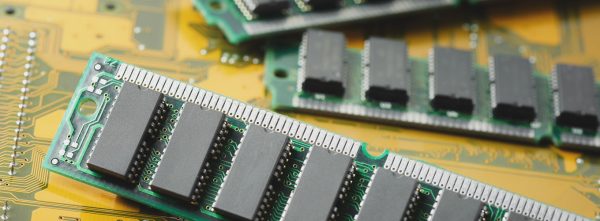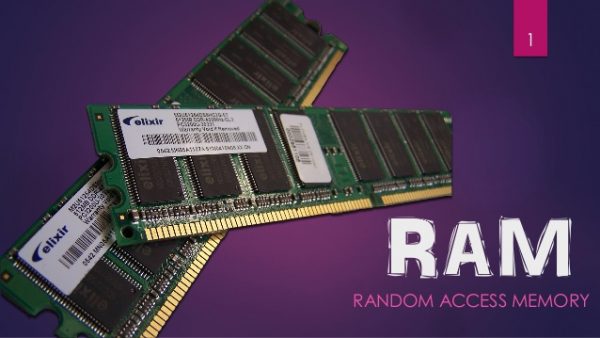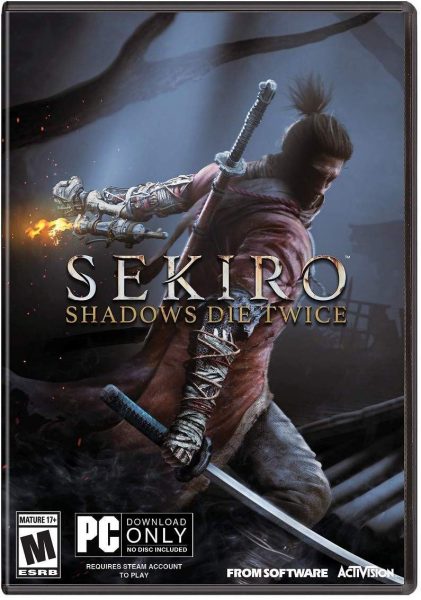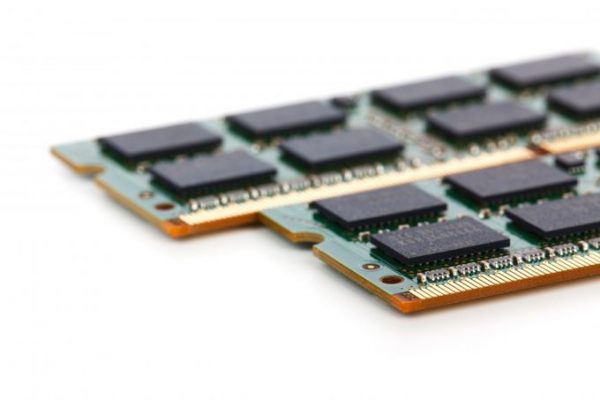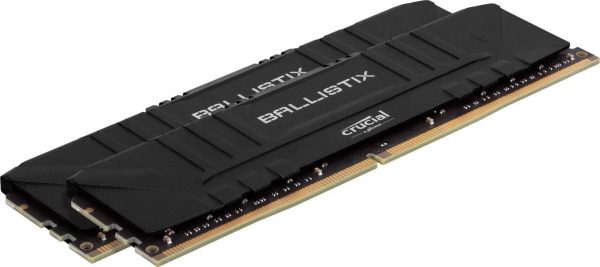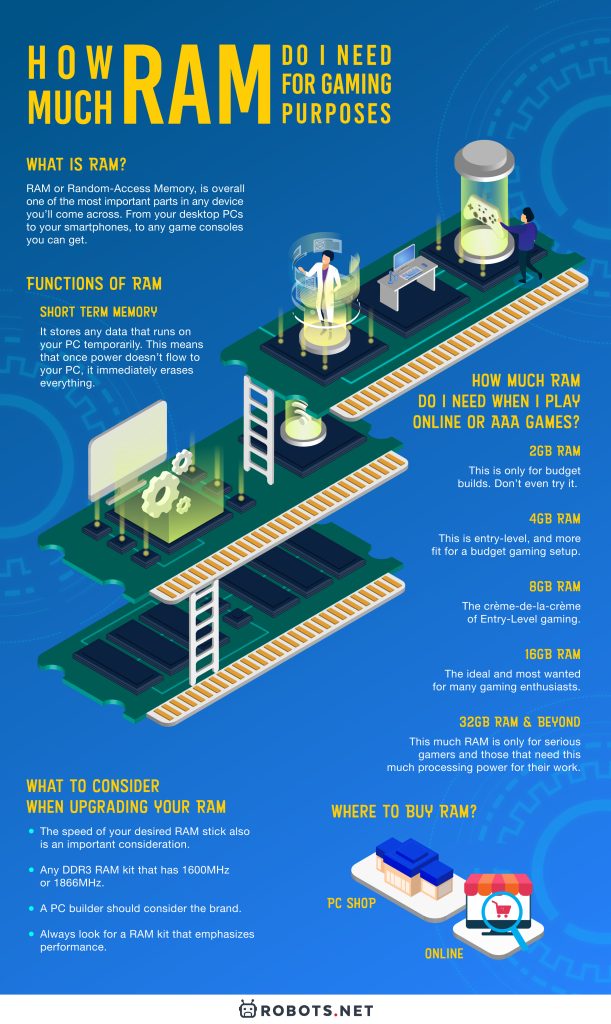What is RAM?
RAM or Random-access memory, is overall one of the most important parts in any device you’ll come across. From your desktop PCs to your smartphones, to any game consoles you can get. If your device doesn’t have RAM, doing a task on any system in question would slower. MUCH slower. If you don’t have enough for the app or game you’re currently trying to use it can bring said app or game to a crawl or even stop them from even running. But you might be wondering, what exactly IS RAM? Well, in a nutshell, it’s a very fast part of your PC that temporarily stores all information your PC might need now or soon. Getting that info in the RAM is a fast affair, compared to slower hard drives that provide longer-term storage.
Functions of RAM
Short Term Memory
RAM is essentially your device’s short-term memory. It stores any data that runs on your PC temporarily, like the services in your Windows PC, the tabs on your web browser, your open image editing tool, or that new game you’re currently playing. You won’t like your PC’s CPU to dig through your slower HDD/SDD storage every time you open a new browser tab or load a new enemy for you to eviscerate. As fast as PC and device storage is when you compare it to drives of the old days, they’re still slower than RAM. Data that are in your PC’s short-term memory, or RAM, can be taken and read from anywhere at nearly the same speed. This is due to the hard-wired connection it has to your system, there’s no real latency through connection or cabling. Although, like short-term memory, RAM won’t remember everything forever. It’s “volatile” tech after all. This means that once power doesn’t flow to your PC, it immediately erases everything. This makes them great for tackling the myriad of high-speed tasks that your OS throws at them on a near-daily basis. However, it’s also the reason why you’ll need storage systems like hard drives and SSDs, as they hold your device info when it’s time to turn the system off.
Significance of RAM when it comes to gaming
Now, the answer to this particular question should be fairly straightforward, but nope. It isn’t. As for why? This is because there’s quite a bit of misinformation when it comes to just how much RAM you need to play many AAA games. If we’re talking about this topic a decade ago, picking the correct RAM brand for your PC that takes into account your capacity, speed, and configuration needs are a wee bit more problematic compared to today. Luckily for us, that’s no longer the case.
What Does RAM Do to Gaming Anyway?
RAM (Random Access Memory) is where your PC places programs and data when they’re being processed. Take any game as an example. Usually, said the game is stored on an HDD or SDD, but constantly taking game data from your PC’s HDD is slow and VERY inefficient. This is where RAM shows it’s important as it gives your PC the ability to access data quickly, so your PC will move important game data that it needs to the RAM for quicker loading time. If you don’t have an adequate amount of RAM for your rig, your PC wouldn’t have the ability to store the game data it needs to run your favorite games, which will lead to laggy frames, a general lack of definition to images, and an overall poor experience for the player. It is, however, worth noting, that a lot of dedicated GPUs already have built-in RAM. This is more commonly known as vRAM. vRAM redefines itself from the average system RAM due to its pure focus on sending graphics and other video-related data to your PC monitor. This is the area where it gets interesting. Mainly because if you want to play games in 4K, It’s typically recommended to increase your vRAM over system RAM to prevent performance issues. It’s a sad fact that gone are the days when 4GB of RAM is the norm for gaming. With the myriad of updates, patches, and developments that are made throughout the years, 4GB of RAM just won’t cut it anymore. However, all is not lost. Due to the prices of RAM kits dropping compared to before, it now makes more sense to get your money’s worth and obtain more than 4GB of RAM. HOWEVER, let’s discuss why.
How much RAM do I need when I play Online or AAA Games?
For starters, the answer to this very question isn’t as straightforward as it seems. As for why? This is because there’s quite a lot of misinformation around how much RAM your current AAA games need. If we’re talking about this topic a decade ago, choosing the right RAM brand with the capacity, speed, type, and configuration that you need for this was more problematic compared to today. Luckily, we now have it easier compared to our predecessors. With this in mind, the next question you’re gonna wish to ask yourself is: “How much RAM do I want for my PC?” And well, here’s the rundown:
2GB
This is only for budget builds. Don’t even try it. Your PC might be able to play Minecraft at this RAM level. However, don’t expect that same PC to play a game like Sekiro: Shadows Die Twice.
4GB
This is entry-level, and more fit for a budget gaming setup. At this point, you can play Watch Dogs 2, and Mirror Edge: Catalyst. These games are an example of titles with lower video quality and decent frame rates.
8GB
The crème-de-la-crème of Entry-Level gaming. This is where the fun begins. With this much RAM, you can now play games like Witcher 3, GTA 5, and Dying Light with better graphics and still have a good frame rate.
16GB
The ideal and most wanted for many gaming enthusiasts. If you can get this much RAM and have a decent Video Card for your PC, you’re pretty much set for the next decade of Gaming. At this point, however, expect that the return of an investment will begin to drop. DON’T go beyond 16GB if you’re just looking to use your PC for games.
32GB and beyond
This is for people who want to show off or are enthusiasts and purpose-built workstations only. This much RAM is only for serious gamers and those that need this much processing power for their work. An example would be engineers, video editors, and others.
Our Suggestion
For those that can afford it, 16GB RAM is the way to go if you want to play good games. As mentioned before, it’s future-proof and will have your gaming and other misc. needs covered for the whole of your PC’s lifespan. If you’re unsure or have tight purse strings, 8GB is a viable choice to make. It’s a great way to cut some corners and would still allow you to play some of the best games currently out there. Though do note that many AAA games released in the current time are already using more than 8GB of RAM. So, while 16 GB is the default amount of RAM you should have in 2020, you can still play many games with 8 GB if you wish. Besides, improving your PC from 8 GB to 16 GB further down the road would be an easy affair and would hardly be a problem. This is, logically, how much RAM for gaming purposes you’ll ever need. Upgrading your RAM is highly-suggested to prolong your gaming PC’s lifespan. Hopefully, that answers the question of “how much RAM for gaming do you really need?”.
How Do You Get more RAM?
The simplest hardware upgrade you can do to make your PC faster is to upgrade your RAM. That’s pretty much a given. Over the years, OS like Windows, software like Adobe, or now even web browsers like Google Chrome, have somehow gained a reputation for being unabashed and unapologetic memory hogs. Older PCs, meanwhile, would often have the ballpark of 2GB and 4GB of RAM. Because of this, even opening too many tabs in Chrome can slow your PC to a snail’s pace. And don’t even mention planning to open multiple programs at a time. That way lies a SLOW PC. If your PCs feeling slow when you have multiple things going on with it. You might want to consider improving your RAM. Typically, 8GB is the minimum that many people recommend for a modern PC rig.
What To Consider When Upgrading Your RAM
There are different types of RAM. Currently, however, most computers use DDR3 memory. And though there are older systems that may need DDR2 or DDR, and a small part of high-end PCs now need DDR4, for now, DDR3 is the head honcho. The speed of your desired RAM stick also is an important consideration. This is in addition to how big the capacity of its memory kit is. However, what’s discovered out of the memory bandwidth testing that people have done over the past few years is that there’s little benefit to buying the fastest RAM you can get. Yes, you heard it right. Faster isn’t ALWAYS better. You should look past the flashy (and unnecessary) 2666MHz and 2400MHz RAM kits and buy from the price/performance sweet spot: Any DDR3 RAM kit that has 1600MHz or 1866MHz. Forever proving the adage that it’s not how fast you can finish, it’s how it’s finished. The next issue a PC builder should consider is brand. Like many products of note, there’s a lot of RAM brands currently available in the market. Some examples would be Corsair, Kingston, Patriot, Crucial, Super Talent, and others. The biggest difference between many brands in this list is how the heat sinks on the RAM modules are designed. Pick the brand that you trust and have an acceptable compromise between aesthetics and a price that you can swallow. However, always look for a RAM kit that emphasizes performance. After all, just because it looks good doesn’t mean it’s good for you.
Where to Buy RAM?
If you’re looking to build your dream desktop, here is our How to Build A Gaming PC guide to help you out. Besides that, why not check our articles on the best graphics cards, best gaming mouse models, best gaming keyboards, and best CPU coolers.
